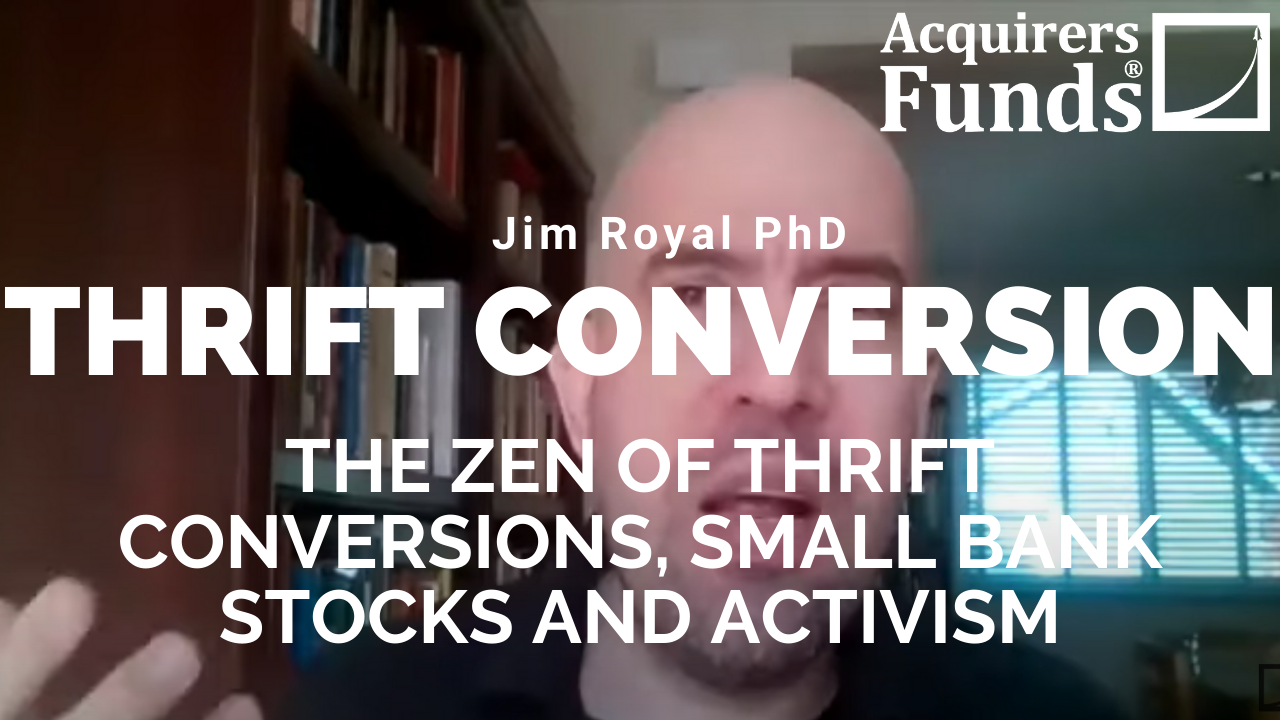During his recent interview with Tobias, Jim Royal Ph D, the author of The Zen of Thrift Conversions: How To Turn Hidden Bank Stocks Into Big Gains, discussed Valuing Thrifts. Here’s an excerpt from the interview:
Tobias: Let’s say you find one of these opportunities, how do you then size that up? How do you determine whether it’s an interesting opportunity for you? What are you looking for?
Jim: Yeah, so I think, in the book, one of the things I go through is a nine-step checklist to really give you a good first rough cut on whether the thrift looks interesting. If I really had to boil that down to three qualities, I’d look at price to tangible book value, return on equity, and equity to assets. Price to tangible book will give you some sense of what upside you might have.
One of the great things about investing in thrifts is this is not an open-ended growth opportunity. If you sell today, it’s not probably likely to double, but you have some range in which your value is. Based on whatever your buy price is, if you can buy at 70% of tangible book, you know you probably have good upside at least until 100% of tangible book.
Then a lot of these over time, the average multiples of round 140% of tangible book that these get bought out at. It can be relatively easy to calculate your potential returns and potential IRRs here. Price to tangible book is one great quality to look for. Return on equity, you want to see consistent record of profitability here so that they aren’t burning your margin of safety with taking down book value.
Tobias: What sort of returns on equity do they tend to have because I imagine if there are mutual– they’re not necessarily run for profitability? How do you make that translation from mutual to now for profit?
Jim: For some, it’s difficult. In many cases, these banks are raising 150% more capital than they already have. They’re suddenly like, we’ve got all this money, returns on equity plummet. In any case, they’re small, they’re subscale, they’ve got a stretch of fixed costs against a basically small revenue base, small customer base. The returns on equity, a good one might be 5% or 6% in general because you’re dealing with banks that have $250 million in assets, $500 million in assets, maybe sometimes a billion in assets.
They’re just not really upscale, and then I’ll point out the final one, equity to assets is a great metric to look at here because that gives you some idea of how much buybacks they can do, how much excess capital they have in the business.
The equity assets also give an activist who comes in, some room to work with in terms of pushing stock repurchases, which is a really a big tool in the activist playbook, pushing more of that money, either buying back the tangible book, or buying back up to tangible book value, and just getting that money back to shareholders. Of course, then it provides safety, gives you some margin of safety if they write some bad loans or things like that. The equity assets is a great one to look at.
Tobias: What do you look for there? What’s the outer limit of where you feel it’s safe?
Jim: The strange thing is that these banks have a serious problem when they go public. They have ridiculous amounts of cash. It’s really not at all unusual. I’ve got my spreadsheet of thrifts, and you’ve got these new thrifts with easily 15% to 16% equity to assets. It’s not unusual to see them with 20% equity to assets, one that completed its second-step conversion, I think it was last year, has over 30% equity to assets.
When you start getting down to 10 or below, the activist doesn’t have a lot of room to work there, can’t force a big buyback. Even if the company was or management was predisposed to do a buyback, they just don’t have a lot of room to work, a lot of room to manoeuver.
Tobias: Do you spend any time examining the nature of the assets that they have? Is it checking accounts and things like that? Or do you look at the loans that they’ve made against commercial real estate somewhere a bit racy, like Las Vegas or something like that?
Jim: Yeah. If you’re looking at deposits on the liability side, one of the big things is how valuable is that franchise. Definitely looking for– this is one of my nine metrics. You want to see how much is timed deposits versus non-timed deposits. If you’ve got a lot of stuff in checking, savings, money markets, that’s more valuable for an acquirer than your CDs and things like that.
That definitely gives you an idea of how valuable or whether it would be more valuable to an acquirer. Since that’s largely the endgame here, that’s something you want to be aware of. Then, yeah, if you’re looking at assets, so many these are really focused on residential type of stuff, like really plain vanilla kinds of stuff. I admit, that’s a pretty broad brush, but a lot of these thrifts are located in relative– they’ve got one or two or three or four branches, and they’re small rural areas, in some cases, not all, so they don’t usually have particularly, especially risky lending generally.
You can find out more about Tobias’ podcast here – The Acquirers Podcast. You can also listen to the podcast on your favorite podcast platforms here:
For all the latest news and podcasts, join our free newsletter here.
Don’t forget to check out our FREE Large Cap 1000 – Stock Screener, here at The Acquirer’s Multiple:




